Kayak vs Canoe
While a canoe and a kayak may appear to be identical, they differ in a number of ways that make them best suited to various settings and uses. In other words, if a canoe is an all-purpose minivan or SUV, a kayak is a slick two-seater sports car. Take it for what it’s worth.
Despite the fact that many people confuse the two terms, there is a distinct difference between a kayak and a canoe. The boats are unique. The equipment is unique. Even the past is distinct. However, few people are aware of these distinctions.
The goal of this informative post is to (literally) define the distinctions between a canoe and a kayak. So that the next time someone asks you a question, instead of responding with three half-formed mumble sentences and fumbling awkwardly for your phone, you can respond with confidence.
Canoe: An open-deck watercraft with a single-bladed paddle and a sitting or kneeling rowing position.
Kayak: A closed-deck watercraft with a double-bladed paddle and a sitting position with legs extended out.
Kayak Vs Canoe : The Difference
The primary distinction between a kayak and a canoe, or between kayaking and canoeing, is the type of vessel used.
Table of Contents
Kayak VS Canoe : The Key Differences
There’s a lot to learn about kayaking, and there’s just as much to learn about canoeing. But, in the end, it all boils down to seven crucial distinctions.
Open vs Closed

The most noticeable difference is in the boats themselves. Canoes are larger and heavier, with a wider frame and open top, similar to a rowboat, and are designed to carry more passengers and gear.
Kayaks are smaller, sleeker boats that are designed for speed or recreation, such as whitewater rapids, open-water sea paddling, or river tours.
There are several types of canoes, but what you’ll most likely see trolling around the lakes near you is a “recreational” or “Canadian” style canoe.
Canoes are generally 13 to 17 feet long, with tall sides that sit higher on the water than kayaks. The paddler sits on benches or kneels on slats that run the width of the beam.
While some kayaks are open-top (also known as “sit-on-top”), the majority are built with a closed cockpit, which means paddlers “sit inside” the craft with their legs covered by the kayak. In essence, you “wear” a kayak while paddling a canoe.
Kayaks are more adaptable, with numerous varieties of kayaks intended to meet a variety of demands. Canoes and kayaks, on the other hand, are now made of high-quality, durable plastic, fibreglass, or even wood or Kevlar, and are both stable and water-worthy.
Seating and Comfort
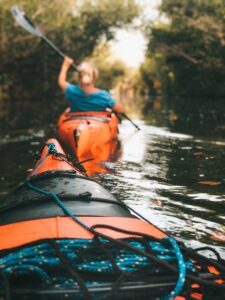
Climbing aboard a canoe is easier than getting in and out of a kayak because of its open-top design — it’s as simple as jumping on board. Paddlers can stand up once inside the canoe by using the sides or a nearby dock for support.
In order to avoid tipping the kayak, the paddler must slide their legs within the cockpit while keeping balance.
Kayakers, on the other hand, may prefer the snug, one-piece feel of a kayak, which provides a little more control and ease of paddling than a canoe.
Kayak cockpits can be fitted with back support, which may appeal to paddlers seeking to go on longer day trips, but in general, a canoe will provide a more pleasant ride due to the open-top format’s greater freedom of movement. A kayaker is essentially “limited” to a cockpit, whereas a canoe paddler is free to go around.
How to Paddle

While a canoe may be more comfortable than a kayak in terms of comfort, the major tradeoff is paddling.
Canoes require more effort to paddle because they are bigger and heavier, and they frequently require two people. In general, paddling a canoe has a steeper learning curve than paddling a kayak.
Kayak paddles have a blade on either end for a single paddler, but canoe paddles are shorter and have a single blade that dips straight into the water and a knob or “T” on the other end.
One hand grips the canoe paddle in the middle for power, and the other grips the paddle at the knob end for control. To keep the canoe tracking straight, two individuals exchange strokes, which is frequently easier said than done.
On a kayak, the paddler clutches the paddle with both hands in the middle and alternately dips either end into the water. Kayak paddle blades are frequently offset at a 90-degree angle from each other, reducing wind resistance and making it easier for the kayaker to get the blade into the proper position while switching sides.
How Wet Will You Get?

In general, because you are sitting higher above the water in a canoe, you will be dryer than in a kayak. A kayak, on the other hand, may fare better in open water or high waves.
Because a kayak’s closed cockpit keeps water out, even the most powerful waves simply wash over the boat. A spray skirt, a piece of fabric or rubber fitted over the top of the cockpit to prevent water from seeping in, can also be added to a kayak.
While a canoe is undeniably more difficult to capsize than a kayak (though they’re both pretty stable), a kayak has the advantage of being able to be righted in the event of a rollover.
Kayakers interested in long-distance touring or sea kayaking should learn safety techniques such as the “Eskimo roll.” If done correctly, it can mean the difference between a ruined weekend and a minor hiccup.
If you manage to flip a canoe, let’s just say you’re up a creek.
So, will you get wet in a kayak on calm waters? Probably not if you’re a careful paddler. However, if some water does get into the boat, it’s a good idea to have a bilge pump on hand.
Stability and Maneuverability

A canoe will be more stable than a kayak in general, but a kayak will be faster and easier to manoeuvre.
This is due to the fact that a kayak is generally narrower and built with the bow and stern slightly curved upwards — a feature known as “rocker,” which means less of the hull is actually in the water.
Less hull in the water (and thus less water to be displaced) means less paddling resistance. Many kayaks also have built-in rudders and skegs to help with steering, and because of the lower centre of gravity, each paddle stroke requires less effort.
Tracking (moving in a straight line) is arguably easier in a kayak than in a canoe. Because kayak paddles are double-sided, the kayaker does not need to change body position to keep the kayak straight. In essence, a single kayaker has complete control of the boat, which means that kayaks will generally get you where you want to go with minimal effort.
Canoes, on the other hand, have an advantage in terms of stability for the opposite reason. The wider hull of a canoe provides greater stability on calm waters, allowing the paddler to move around the boat without fear of tipping. To be honest, modern kayaks and canoes are both quite stable and difficult to capsize.
25 Fun Things To Do In Ontario CA
How To Use It?
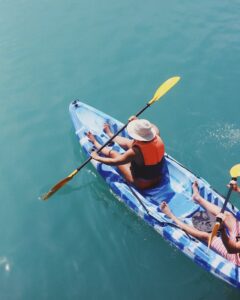
Both kayaks and canoes can be used for a variety of activities, including fishing, long-distance trips, river paddling, and camping, but each has distinct advantages.
Canoes may be a better option for those looking to spend a relaxing day on a calm lake with a cooler and some friends because they provide more storage space — for both people and gear.
A kayak, on the other hand, is likely to be more suited to adventure-type trips like whitewater rafting, ocean paddling, or deep-water fishing.
Depending on the type of trip you’re doing, either option could be excellent for sightseeing — or multi-day adventures. While a canoe might provide a more peaceful experience through inland rivers and lakes, if you want to explore open waterways like the Great Lakes or the ocean, you’ll need a sea kayak.
While canoes are the traditional choice for those looking to do some napping… err, angling, kayak fishing is becoming more popular. Modern fishing kayaks are designed for those who are serious about the sport, with rod holders, deep wells for gear, and even foot pedals instead of paddles.
When deciding between a kayak and a canoe, consider how you intend to move it. While kayaks can be transported in practically any vehicle — with inflatable and foldable kayaks making transfer even easier — a canoe’s bulkier size necessitates a little more planning. A canoe can be carried in most SUVs, however two canoes will almost probably not fit in one vehicle.
Storing Your Gear
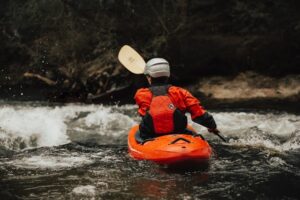
When it comes to carrying gear, a kayak differs from a canoe. Canoes, on the other hand, offer more versatility, with a broad deck that allows you to easily store larger coolers or camping gear.
While kayaks, especially bigger sea kayaks, have plenty of storage capacity, it’s usually found below deck in waterproof cargo compartments. Although most kayaks have a small dry storage compartment directly behind the cockpit, accessing gear while on the water can be difficult if you don’t plan ahead.
The essential term in kayak storage, though, is “waterproof.” Your electronics, medicine, telephone, or camping goods have a considerably better chance of surviving on a kayak in the case of severe waves or even a capsize.
However, because you don’t have to empty the cargo compartments beforehand, portaging — moving the boat over dry land — of gear is often made easier in a canoe.
KAYAK VS CANOE: THE GEAR
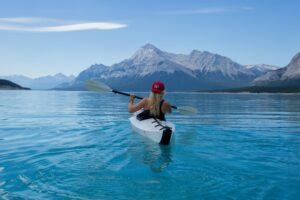
So far, we’ve discussed the fundamental differences in equipment between a canoe and a kayak. Specifically, the type of watercraft you utilise. But let’s delve a little deeper (just a smidgeon) into the advantages of each of these.
A canoe’s open-top design means the inside deck is less shielded from the elements than a kayak’s closed-top design. A canoe has high sides as a result of this, making it more difficult for water to jump up and splash you while you paddle.
You’ll be closer to the water in a kayak than in a canoe since it’s lower. Water can only enter a kayak through a little hole (which is also where you’ll be sitting!). Because it’s more difficult to get water out of a kayak if it becomes wet, many kayakers use a spray deck to keep water out.
This does make getting out of the kayak a little more difficult, so if you’re going to use a spray deck, make sure you’re comfortable putting it on and off and rolling out of your kayak – you may need to do it underwater if you capsize!
You can try to learn a “eskimo roll” if you’ve mastered the fundamentals of kayaking and using a spray deck. If you capsize your kayak, you can recover by doing an eskimo roll. Once your kayak is upside down in the water, you may force it upright with your paddle and body without ever exiting the boat. It’s a fantastic skill to master.
Kayaks are far more agile and nimble than canoes, thanks to their design, smaller weight, and double-bladed paddle, which allows for faster and more agile navigation. Canoes, on the other hand, are more stable and less likely to capsize.
KAYAK VS CANOE: WHERE TO GO TO TRY IT
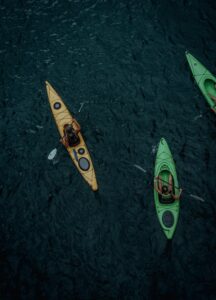
Kayaking and canoeing can be done anywhere there is water. The ocean, a nearby canal, or even your local swimming pool – though good luck getting a kayak through the doors without the receptionist asking you a few probing questions.
Naturally, not many people own canoes or kayaks, as they can be quite expensive and difficult to store. So, if you want to go canoeing or kayaking, it’s best to search Google for a rental location near you. Wherever there’s water, there’s usually a boat.
How to Choose

In the end, there is no right or wrong answer in the great kayak vs. canoe debate. Which you choose will be determined by what you hope to gain from your paddling experience. We prefer kayaks at American Paddler, but who are we to say that thousands of canoe enthusiasts are wrong?
If you decide a kayak is right for you, we’ve compiled a comprehensive list of the best sea kayaks, inflatable kayaks, and sit-on-top kayaks to assist you in making your decision.
Make the most of your experience by simply getting out on the water, regardless of which boat you choose. Bring a companion. Please bring a beverage. Bring a lifejacket with you.
Also, don’t forget to bring sunscreen.
KAYAK VS CANOE: A QUICK HISTORY

The term “canoe” is derived from the Carib kenu (dugout) and the Spanish canoa. When you think about it, the name makes sense, and a ‘dugout canoe’ is still an alternative name for a canoe, particularly one made from a hollowed tree trunk.
The Pesse canoe, discovered in the Netherlands, is the oldest canoe ever discovered, dating back to 8200 BC. This is not only the world’s oldest canoe, but also the world’s oldest known boat.
America’s indigenous peoples are well known for their canoes. When Europeans first began exploring the area in the 14th, 15th, and 16th centuries, they were awestruck by the designs of the canoes, which went on to play an important role in European exploration of – particularly the interior of – North America.
Kayaks can be traced back to Alaskan, Canadian, and Greenland Inuit tribes. They were commonly used for hunting and were made of wood with seal skin stretched over the top to provide a closed top. Kayaking was later popularised in Europe by Scandinavian explorers.
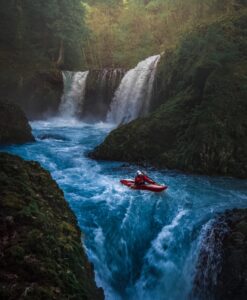
Canoeing was featured as a demonstration sport at the Olympic Games in 1924. Canoeing became a full Olympic sport 12 years later, at the notorious 1936 Olympic Games (best remembered for being hosted by Adolf Hitler’s Nazi Germany). There were nine events, all in the canoe sprint, and they were all for men only. Canoeing and kayaking did not enter the Olympics as a women’s sport until 1948.
Rotomolded polyethylene is now one of the most commonly used materials in the manufacture of kayaks and canoes. It’s adaptable, durable, and reasonably priced. Fiberglass is also popular due to its ultralight weight, responsiveness, durability, and ease of repair – and wood remains popular as well. Although it is not recommended for white water, it does make you feel like an old-time explorer.
Comments